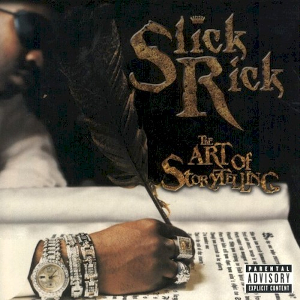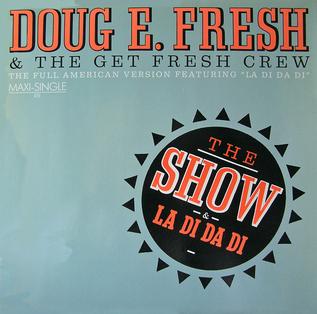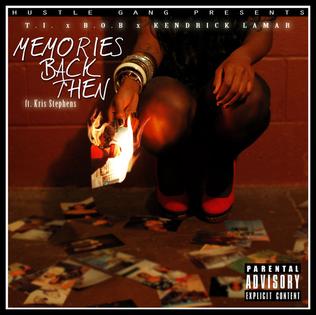The new school of hip hop was a movement in hip hop music, beginning in 1983–84 with the early records of Run–D.M.C., Whodini, and LL Cool J. Predominantly from Queens and Brooklyn, it was characterized by drum machine-led minimalism, often tinged with elements of rock; rapped taunts, boasts, and socio-political commentary; and aggressive, self-assertive delivery. In song and image, its artists projected a tough, cool, street b-boy attitude. These elements contrasted sharply with funk and disco, novelty hits, live bands, synthesizers, and party rhymes of artists prevalent in the early 1980s. Compared to their older hip hop counterparts, new school artists crafted more cohesive LPs and shorter songs more amenable to airplay. By 1986, their releases began to establish hip hop in the mainstream.

Nathaniel Thomas Wilson, better known by his stage name Kool G Rap, is an American rapper. He began his career in the mid-1980s as one half of the group Kool G Rap & DJ Polo and as a member of the Juice Crew. He is widely considered to be one of the most influential and skilled MCs of all time, and a pioneer of mafioso rap/street/hardcore content and multisyllabic rhyming. On his album The Giancana Story, he stated that the "G" in his name stands for "Giancana", but on other occasions he has stated that it stands for "Genius".

The Beatnuts is an American hip hop group and production duo from New York City. Its current members are JuJu and Psycho Les. JuJu is a Dominican American from Corona and Psycho Les is a Colombian American from Jackson Heights, Queens. Although only peripheral members, they are routinely acknowledged by Q-Tip as being members of Native Tongues. The Beatnuts were originally a trio before Fashion, now known as Al' Tariq, left the group to start a solo career. V.I.C. was also a member of The Beatnuts' production team for a while.

Douglas Davis, known professionally as Doug E. Fresh, is a Barbados-born American rapper, record producer, and beatboxer, also known as the "Human Beat Box". The pioneer of 20th-century American beatboxing, Fresh is able to accurately imitate drum machines and various special effects using only his mouth, lips, gums, throat, tongue and a microphone.

Critical Beatdown is the debut studio album by American hip hop group Ultramagnetic MCs, released on October 4, 1988, by Next Plateau Records. Production for the album was handled primarily by the group's rapper and producer Ced-Gee, who employed an E-mu SP-1200 sampler as the album's main instrument. Music journalists have noted the album for its innovative production, funk-based samples, self-assertive themes, and clever lyrical rhymes by Ced-Gee and rapper Kool Keith.

The Pretty Toney Album is the fourth studio album by American hip hop artist Ghostface. Originally scheduled for a February 2004 release, the album was released on April 20, 2004, by Def Jam. It is the only album from the artist to be released solely under the moniker "Ghostface", and is the first of his albums not to feature any other members of the Wu-Tang Clan.

The Hip Hop Honors is an annual event that airs on VH1. The television special honors old school and golden age hip hop rappers and contributors for their long-term influence and importance in the history of hip hop culture. It features live performances by most of the honorees along with new artists who have been influenced by them in tribute. The show is taped at the Hammerstein Ballroom in Manhattan, New York City.

Golden age hip hop refers to mainstream hip hop music created from the mid or mid-late 1980s to the early or early-mid 1990s, particularly by artists and musicians originating from the New York metropolitan area. A successor to the new-school hip hop movement, it is characterized by its diversity, quality, innovation and influence on overall hip hop after the genre's emergence and establishment in the old-school era, and is associated with the development and eventual mainstream success of hip hop. There were various types of subject matter, while the music was experimental and the sampling from old records was eclectic.

14 Shots to the Dome is the fifth studio album by American hip hop recording artist LL Cool J. It was released on March 30, 1993, via Def Jam Recordings. Recording sessions took place at Marley's House Of Hits, at Cove City Sound Studios and at Unique Recording Studios in New York, and at QDIII Soundlab in Los Angeles, at Bobcat's House in Palmdale, and at Encore Studio in Burbank. Production was handled by Marley Marl, DJ Bobcat, Quincy Jones III, Andrew Zenable and Chris Forte. It features guest appearances from Lords of the Underground and Lieutenant Stitchie.

The Iceberg/Freedom of Speech... Just Watch What You Say! is the third studio album by American rapper Ice-T, released on October 10, 1989, by Sire Records. The album has an uncharacteristically gritty sound, featuring some of the darkest tracks that Ice-T ever released.

The Ruler's Back is the second studio album by British-American rapper Slick Rick, released in 1991 on Def Jam Recordings.

The Art of Storytelling is the fourth and most recent studio album by British-American rapper Slick Rick. Originally scheduled for a February 1999 release, it was ultimately released May 25, 1999, on Def Jam Recordings. The album features production from DJ Clark Kent and Kid Capri, among others. Upon its release, The Art of Storytelling proved to be Slick Rick's highest-charting album, peaking at number eight on the Billboard 200, and number one on the Top R&B/Hip-Hop Albums, and was certified gold by the RIAA within a month of its release.

"La Di Da Di" is a song performed by Doug E. Fresh, who provides the beatboxed instrumental, and MC Ricky D, who performs the vocals. It was originally released in 1985 as the B-side to "The Show". The song has since gained a reputation as an early hip hop classic, and it is one of the most sampled songs in history.

"Runaway Love" is the third single released from Ludacris' fifth album, Release Therapy (2006). The song, which features Mary J. Blige on the vocals, was produced by Polow da Don and reached #2 on the Billboard Hot 100 singles chart only behind Justin Timberlake's "What Goes Around... Comes Around". The song was the first single from Release Therapy in the United Kingdom and was released as a double A-side with "Girls Gone Wild" included. The song was performed at the 2007 Grammy Awards show by Ludacris, Mary J. Blige and Earth, Wind & Fire. A remix of the song is available by T-Pain featuring Cassie.

Keepers of the Funk is the second studio album by American hip hop group Lords of the Underground. It was released on November 1, 1994 via Pendulum Records. Recording sessions took place at House of Hitz in Chestnut Ridge, New York. Production was handled by Marley Marl, K-Def, Lords of the Underground and Andre Booth. It features guest appearances from Sah-B, Deniece Williams, George Clinton, Brian "Bre" Williamson and Supreme C. The album did gain some success, making it to No. 57 on the Billboard 200 and No. 16 on the Top R&B/Hip-Hop Albums chart.
"The Show" is a single by Doug E. Fresh & the Get Fresh Crew. Described as "a reality show of a Hip Hop performance" the track focuses on a conversation between Doug E. Fresh and MC Ricky D as they prepare for a show. The song incorporates portions of the melody from the theme song of the animated series Inspector Gadget. The original issue of the song featured a line where Slick Rick mockingly sings a verse from the Beatles' "Michelle" (1965), but all subsequent reissues have removed this line since the rights to the song were never secured.

"Sucker M.C.'s" is a song by American hip hop group Run-D.M.C. It was first released in 1983 as B-side to "It's Like That". The two-sided release marked the start of Run-D.M.C.'s career as their first single, and it is widely regarded as ushering in a new school of hip hop artists with a street image and an abrasive, minimalist sound that marked them out from their predecessors. Both tracks were collected on the trio's self-titled debut album in 1984. WBAU was the first station to play the two songs.

The Block Brochure: Welcome to the Soil 3 is the seventeenth studio album by the American rapper E-40. It was released on March 26, 2012, by Heavy on the Grind Entertainment and EMI. The album is the third part of The Block Brochure: Welcome to the Soil series, along with other parts, including The Block Brochure: Welcome to the Soil 1 and The Block Brochure: Welcome to the Soil 2. E-40 has released four albums into each pairs, including Revenue Retrievin': Day Shift (2010), Revenue Retrievin': Night Shift (2010), Revenue Retrievin': Overtime Shift (2011) and Revenue Retrievin': Graveyard Shift (2011). The album features guest appearances from the comedian Katt Williams and the American singer-songwriter Raheem DeVaughn, with the rappers Snoop Dogg, Tha Dogg Pound, Kokane, Kendrick Lamar, Droop-E, Too Short, Kaveo, Stressmatic, B-Legit, Willy Will and Hieroglyphics, among others.

"Memories Back Then" is a song by American hip hop recording artist T.I., featuring guest appearances from fellow American rappers B.o.B and Kendrick Lamar, as well as vocals from American singer-songwriter Kris Stephens. The song, produced Maurice "Kenoe" Jordan, was initially released as a single by Hustle Gang on April 22, 2013. The song debuted and peaked at number 88 on the US Billboard Hot 100 chart.

This is the discography for English-American hip hop musician Slick Rick. It includes 4 studio albums and 17 singles, including 8 as a featured artist.



















